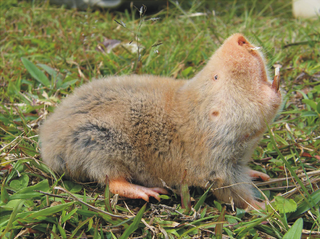
The silvery mole-rat, silvery blesmol, or silky mole-rat is a species of mole-rat of East Africa which occurs in southern Kenya, Tanzania, southeastern Democratic Republic of Congo, Mozambique and Malawi. Solitary and aggressive, little is known about its ecology or behavior. It is monotypic in the genus Heliophobius. A common species, the International Union for Conservation of Nature has rated it as being of "least concern".

The plains rat(Pseudomys australis), also known as the palyoora, plains mouse and eastern mouse, is a conilurine rodent native to arid and semi-arid Australia. Referred to as the pallyoora or yarlie by Indigenous groups, the plains rat was once widely distributed across central Australia, including north-west New South Wales and south-west Queensland; however, habitat degradation due to grazing, introduced predators and drought have contributed to its decline. Consequently, the plains rat has been listed as 'presumed extinct' in New South Wales and Victoria, 'endangered' in the Northern Territory and Queensland and 'vulnerable' in Western Australia and South Australia. While recent research has indicated the presence of the plains rat in areas such as the Fowlers Gap and Strzelecki Desert regions of New South Wales and within the Diamantina National Park in Queensland, there are only five sub-populations currently recognised nationally, none of which coincide with recent discoveries of the plains rat. As the current population trend of the plains rat has been listed as 'declining' by the International Union for the Conservation of Nature (IUCN), the IUCN conservation status for the species is 'vulnerable'.
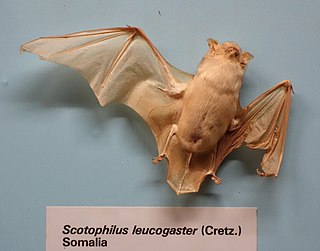
The white-bellied yellow bat or white-bellied house bat, is a species of vesper bat in the genus Scotophilus, the house bats. It can be found in Angola, Benin, Botswana, Burkina Faso, Cameroon, Central African Republic, Chad, Ivory Coast, Gambia, Ghana, Guinea, Guinea-Bissau, Kenya, Mali, Mauritania, Namibia, Niger, Nigeria, Senegal, Sierra Leone, Sudan, Togo, Uganda, and Zambia. It is found in dry and moist savanna and open woodland. It is a common species with a very wide range, and the International Union for Conservation of Nature has assessed its conservation status as being of "least concern".
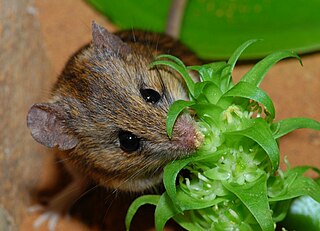
The Namaqua rock rat is a species of rodent in the family Muridae. It is sometimes included in the genus Micaelamys. It is found in Angola, Botswana, Lesotho, Malawi, Mozambique, Namibia, South Africa, Eswatini, Zambia, and Zimbabwe. Its natural habitats are temperate forest, dry savanna, temperate shrubland, subtropical or tropical dry shrubland, temperate grassland, rocky areas, hot desert, temperate desert, rocky shores, arable land, rural gardens, and urban areas.
The West African shaggy rat is a species of rodent in the family Muridae. It is found in Benin, Cameroon, Ivory Coast, Gambia, Ghana, Guinea, Guinea-Bissau, Liberia, Mali, Nigeria, Senegal, Sierra Leone, and Togo. Its natural habitats are subtropical or tropical seasonally wet or flooded lowland grassland and swamps. It is a common species and the International Union for Conservation of Nature has rated its conservation status as being of "least concern".

The hairy-footed gerbil is a species of rodent found in Angola, Botswana, Mozambique, Namibia, South Africa, and Zimbabwe. Its natural habitats are dry savanna, temperate shrubland, hot deserts, sandy shores, and urban areas. All members of this genus have hair on the soles of their feet, hence the name. They prefer sandy soil or sandy alluvium with grass, scrub or light woodland cover.
The Namib brush-tailed gerbil or Setzer's hairy-footed gerbil is a species of rodent endemic to Angola and Namibia. Its natural habitats are sandy and gravelly plains. It stays in its burrow by day, emerging at night to feed on arthropods, vegetable matter, and seeds.
The dune hairy-footed gerbil, or the Namib dune gerbil is a species of rodent found only in Namibia. Its natural habitat is temperate desert where it lives in loose sand among sand dunes, feeding opportunistically on arthropods, seeds and green vegetation.

The Southern African vlei rat is a species of rodent in the vlei rat genus, Otomys, of the family Muridae in the order Rodentia. This is the type species of the genus. It is native to the grasslands and swamps of southern Africa where it is a common species.
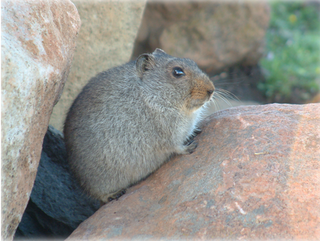
Sloggett's vlei rat or ice rat is a species of rodent in the family Muridae. It is found in southern Lesotho and South Africa where its natural habitats are subtropical or tropical high-altitude grassland, swamps, and rocky areas. Its name commemorates Col. Arthur Sloggett who served in South Africa and collected at Deelfontein in 1902. This is a common species and the International Union for Conservation of Nature has rated it as being of "least concern".

Brants's whistling rat or Brants' whistling rat is one of two species of murid rodent in the genus Parotomys. It is found in Botswana, Namibia, and South Africa where its natural habitats are subtropical or tropical dry shrubland and pastureland. It was first described in 1834 by the Scottish zoologist Andrew Smith who named it in honour of the Dutch zoologist and author Anton Brants.

Parotomys is a small genus of rodent in the family Muridae. Member species are found in the African countries of Botswana, Namibia, and South Africa. It contains the following two species:
The tiny fat mouse is a species of rodent in the family Nesomyidae. It is found in Angola, Botswana, Ethiopia, Kenya, Mozambique, Namibia, South Sudan, Tanzania, Uganda, Zambia, and Zimbabwe. Its natural habitats are subtropical or tropical dry shrubland and subtropical or tropical dry lowland grassland.
Boehm's gerbil is a species of rodent found in Angola, Burundi, Democratic Republic of the Congo, Kenya, Malawi, Mozambique, Rwanda, Tanzania, Uganda, and Zambia. Its natural habitats are dry savanna, moist savanna, and arable land. This is a common species with a wide distribution which faces no obvious threats, so in 2004 the International Union for Conservation of Nature rated its conservation status as being of "least concern".
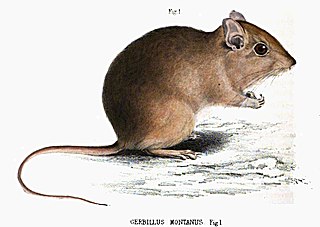
The highveld gerbil is a species of rodent found in Angola, Botswana, Lesotho, Namibia, South Africa, Eswatini, Zambia, and Zimbabwe. Its natural habitats are dry savanna, temperate shrubland, subtropical or tropical dry shrubland, temperate grassland, and temperate desert. This is a common species with a wide range and the International Union for Conservation of Nature has rated it as being of "least concern" as of 2008.

The black-tailed tree rat, also called black-tailed acacia rat or black-tailed thallomys,, is a species of rodent in the family Muridae. It is found in Angola, Botswana, Namibia and South Africa, where its natural habitat is subtropical or tropical dry shrubland. It is both nocturnal and arboreal and makes bulky nests in the trees, often acacias, where it feeds on leaves and buds.

Bennett's chinchilla rat is a species of chinchilla rat in the family Abrocomidae. It is found only in Chile where its habitat is Mediterranean-type scrub on the western side of the Andes. The IUCN has assessed its conservation status as being of "least concern".

Duthie's golden mole is a species of mammal in the family Chrysochloridae. It is endemic to South Africa. Its natural habitats are subtropical or tropical moist lowland forests, moist savanna, temperate grassland, arable land, pastureland, plantations, rural gardens, and urban area. The specific name duthieae was given in honour of Dr. Augusta Vera Duthie, a South African botanist.
The stone dormouse is a species of rodent in the family Gliridae. It is found in Namibia, South Africa, and possibly Angola. Its natural habitat is rocky areas in the Karoo. Though it has a limited range, it is a fairly common species and the International Union for Conservation of Nature has assessed its conservation status as being of "least concern".












